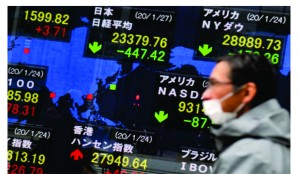Coronavirus and Global Economy
There are growing apprehensions among financial experts that coronavirus outbreak and the economic fallout it has sparked could plunge the world economy into a recession. Having largely ignored COVID-19 as it spread across China, global financial markets reacted strongly when the virus spread to Europe and the Middle East, stoking fears of a global pandemic. Since then, risks have been priced so aggressively that some fear a recession in the global economy may be a foregone conclusion. Italy’s decision to put much of its prosperous north—including its financial capital, Milan—on semi-lockdown, along with an escalating outbreak in the United States and a precipitous crash in oil prices, is forcing economists to reassess their predictions for how the virus will hit growth.
He world appears to be on the brink of a sudden recession. The economic disruption caused by the coronavirus might put an end to what has been a heady decade on the world stock market since, after the 2008 global financial crisis, low interest rates and quantitative easing became the new normal. Markets are registering massive falls of up to 10%, unprecedented since 2008. Billions of dollars are vanishing. The world bourses recently witnessed a Black Monday, all over again.
At the start of this year, things seemed to be looking up for the global economy. True, growth had slowed a bit in 2019: from 2.9% to 2.3% in the United States, and from 3.6% to 2.9% globally. Still, there had been no recession, and as recently as January, the International Monetary Fund projected a global growth rebound in 2020. But the new coronavirus, COVID-19, has changed all of that.
Early predictions about COVID-19’s economic impact were reassuring. Similar epidemics— such as the 2003 outbreak of severe acute respiratory syndrome (SARS), another China-born coronavirus—did little damage globally. At the country level, GDP growth took a hit, but quickly bounced back, as consumers released pent-up demand and firms rushed to fill back orders and re-stock inventories.
It is becoming increasingly clear, however, that this new coronavirus is likely to do much more damage than SARS. Not only has COVID-19 already caused more deaths than its predecessor; its economic consequences are likely to be compounded by unfavorable conditions—beginning with China’s increased economic vulnerability.
China’s economy has grown significantly more slowly in the last decade than it did previously. Of course, after decades of double-digit growth, that was to be expected, and China has managed to avoid a hard landing. But Chinese banks hold large amounts of non-performing loans—a source of major risks.
As the COVID-19 outbreak disrupts economic activity—owing partly to the unprecedented quarantining of huge subsets of the population—there is reason to expect a sharp slowdown this year, with growth falling significantly below last year’s official rate of 6.1%. During the recent meeting of G20 finance ministers, the IMF downgraded its growth forecast for China to 5.6% for 2020—its lowest since 1990.
This could hamper global growth considerably, because the world economy is more dependent on China than ever. In 2003, China constituted only 4% of global GDP; today, that figure stands at 17% (at current exchange rates).
Moreover, because China is a global supply-chain hub, disruptions there undermine output elsewhere. Commodity exporters, including Australia, and most of Africa, Latin America, and the Middle East, are likely to be affected the most, as China tends to be their largest customer. But all of China’s major trading partners are vulnerable.
For example, Japan’s economy already contracted at an annualized rate of 6.3% in the fourth quarter of 2019, owing to last October’s consumption-tax hike. Add to that the loss of trade with China, and a recession—defined as two consecutive quarters of shrinking GDP—now seems likely.
European manufacturing could also suffer considerably. Europe is more dependent on trade than, say, the United States, and is linked even more extensively to China through a web of supply chains. While Germany narrowly escaped recession last year, it might not be so lucky this year, especially if it fails to undertake some fiscal expansion. As for the United Kingdom, Brexit may finally have the long-feared economic consequences.
All of this could happen even if COVID-19 does not become a full-blown pandemic. In fact, while the virus is proliferating in some countries, such as South Korea, a high infection rate is not a prerequisite for economic hardship. The specter of contagious disease tends to have a disproportionate impact on economic activity, because healthy people avoid travelling, shopping, and even going to work.
Some still cling to growth optimism, rooted in recent trade agreements negotiated by US President Donald Trump’s administration: the “phase one” deal with China and the revised free-trade agreement with Canada and Mexico. But while those agreements are far better than they would have been had Trump stuck to the hardline positions he once defended, they do not represent an improvement over the situation that prevailed before he took office; if anything, their net impact is likely to be negative.
Consider the “phase one” deal with China: not only does it leave in place high tariffs; it also remains fragile, owing to a lack of credibility on both sides. In any case, its impact is likely to be limited. China may not be able to deliver on its promise to purchase an extra $200 billion worth of goods from the US, and even if it does, that is unlikely to translate into higher US exports. Instead, those exports will simply be diverted from other customers.
While global recessions are exceedingly difficult to forecast, the odds of one—particularly one characterized by less than 2.5% growth, a threshold set by the IMF—now seem to have risen dramatically. (Unlike advanced-economy growth, global growth rarely falls below zero, because developing countries have higher average trend growth.)
So far, US investors seem unconcerned about these risks. But they may be taking too much comfort from the US Federal Reserve’s three interest-rate cuts last year. Should the US economy falter, there is nowhere near enough room for the Fed to cut interest rates by 500 basis points, as it has done in past recessions.
Even if a recession does not materialize in the near term, Trump’s approach to trade may herald the end of the era when steadily rising international trade (as a share of GDP) buttressed global peace and prosperity. Instead, the US and China may continue on the path toward economic decoupling, within the context of a broader process of de-globalization. COVID-19 did not place the world’s two largest economies on this path, but it could well hasten their journey along it.
Economic Impact on
pakistan
The Coronavirus (COVID-19), since its outbreak in mid-December 2019, has caused turmoil in the world’s second-largest economy, China, with a trickle-down effect on nearly all big economies including those of the European Union, United States, Japan and South Korea. Pakistan also is not immune to its disastrous impacts as Pakistani markets and imports are also starting to feel the impact of the outbreak. In this context, The Asian Development Bank (ADB) recently released a report according to which the impact of the coronavirus, in terms of the global GDP ranges from $77 billion in best case scenario to $347 billion in worst case scenario, or 0.1% to 0.4% of the global GDP, and the total losses likely to be sustained by Pakistan will be only $16.23 million in best case scenario.
It projected that in best case scenario, Pakistan’s agriculture and mining sectors could sustain a loss of $5.5 million; business trade, personal and public service $5.54 million; hotels and restaurants $0.67 million; light and heavy manufacturing $3.6 million and transport services $0.92 million. In moderate case scenario, the projected losses to be faced by Pakistan are $34.2 million. In worst case scenario, the projected losses to be faced by Pakistan are $60.8 million.
In the worst case scenario, Pakistan’s agriculture and mining sectors will face $21.7 million losses; business and trade $18.8 million losses; hotel and restaurants $2.4 million losses; light and heavy engineering $14.6 million losses; and transport services $3.4 million. According to the ADB estimates, around 946,000 people will be unemployed in Pakistan in hypothetical worst case scenario. The net effect of the drop in oil prices due to coronavirus is neutral, yet alarmingly negative for the economy of Pakistan. If this crisis prolongs, it will eventually lead to a significant increase in expenditures; a further slowdown in tax collection; a rise in inflation; and an increase in fiscal deficit. The drop in consumer savings’ will also affect an already depressed demand, leading to a further slowdown in the economy, according to the advisory firm. Exports will temporarily increase because of the lockdown and seize of trade with China.
 Jahangir's World Times First Comprehensive Magazine for students/teachers of competitive exams and general readers as well.
Jahangir's World Times First Comprehensive Magazine for students/teachers of competitive exams and general readers as well.



